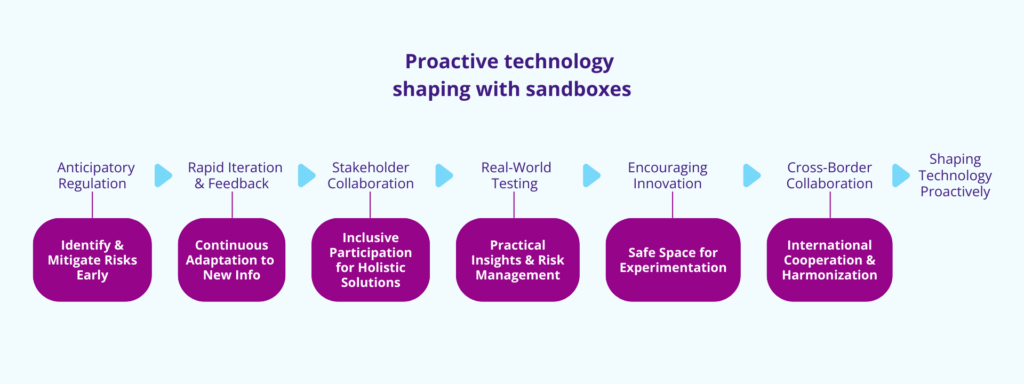In an era where technological advancements seem to outpace our ability to regulate and understand them, societies worldwide find themselves in a constant state of catching up. We are often reacting to the latest innovations, scrambling to implement policies that address unforeseen consequences. As a society, we need to do better and rethink our traditional tools and processes. What if, instead of playing catch-up, we could proactively shape how technology is developed and deployed? Enter the concept of sandboxes – a transformative approach to policy-making, regulation and innovation.
The Sandbox solution
Sandboxes offer a dynamic environment where new technologies can be tested in real-world scenarios under the public-sector oversight. This approach allows for iterative development, real-time feedback, and collaborative engagement among diverse stakeholders. This article is about how sandboxes can shift our position from reactive to proactive.
Anticipatory regulation
Traditional regulatory processes are often linear, with a single point of consultation followed by a fixed outcome. This rigidity can stifle innovation and lead to outdated policies that fail to address emerging technologies’ complexities. Sandboxes, on the other hand, enable testing and refinement of solutions, and in a regulatory framework, the implementation of anticipatory regulation. By allowing policy makers and regulators to interact with new technologies early and often, they can anticipate potential issues and craft flexible policies and regulatory remedies that evolve alongside technological advancements.

Iteration and feedback
One of the core strengths of sandboxes is their iterative nature. Technologies are not static – they evolve through cycles of development and refinement. In a sandbox, each iteration is an opportunity to gather feedback, assess impacts, and make necessary adjustments. This continuous loop of testing and improvement ensures that technologies are robust, safe, and aligned with societal values before they reach the broader market.
Stakeholder collaboration
The prisoner’s dilemma in game theory highlights the potential pitfalls of single-shot interactions, where parties may not cooperate due to mistrust. Sandboxes foster repeated interactions among stakeholders, including government agencies, private sector innovators, academia, and civil society. These repeated interactions build trust, facilitate knowledge exchange, and lead to better outcomes.
It is clear that effective regulation requires more than just consulting the private sector; it demands their genuine involvement in policy and regulatory experimentation. This is crucial for building trust and accountability. By actively engaging private sector stakeholders in sandbox initiatives, we create a space where compliance teams see the value of proactive interaction rather than resorting to damage control after a solution is fully developed.
Regulatory sandboxes offer a win-win process. For innovators, sandboxes reduce legal and regulatory uncertainty by providing a controlled testing environment. This facilitates market entry, enhances competition, and broadens access to innovation. For regulators, sandboxes provide first-hand exposure to the latest technological developments, building capacity and helping anticipate future trends.
When developed collaboratively with input from both innovators and impacted actors, sandboxes can build consensus and trust, fostering innovative collaborations across various stakeholders, including international partners. Sandboxes clarify regulatory requirements where they are vague or missing, and help dismantle barriers to entry that may be disproportionate to the risks. Transparency in sandbox outcomes drives greater public and political understanding of evolving technologies, practices, rules, and norms.
Real-World Testing
Theoretical models and controlled experiments can only go so far in predicting how new technologies will perform in the real world. Sandboxes provide a controlled yet real-world environment where innovations can be deployed and tested under actual conditions. This approach not only identifies potential issues early but also demonstrates the practical benefits and limitations of new technologies, leading to more informed and effective regulatory decisions. Many of the regulatory sandboxes experiences around the world have been carried out in the financial sector, but applications in numerous other areas are growing.
Financial Technology:
- UK Financial Conduct Authority (FCA) Sandbox: The FCA has run multiple cohorts of its regulatory sandbox, allowing FinTech firms to test innovative products in a controlled environment. Companies such as Revolut and Monzo have utilized this sandbox to test new banking services, ensuring they meet regulatory requirements while providing groundbreaking financial solutions to consumers.
- Brazil’s Central Bank (BCB) Sandbox: The Brazilian Central Bank’s experience with sandboxes has been instrumental in the successful development and implementation of PIX, a real-time payment system that has revolutionized financial transactions in Brazil. By providing a controlled environment for innovation, fostering collaboration, and leveraging iterative testing and feedback, the sandbox approach has enabled Brazil to create a cutting-edge payment system that enhances financial inclusion, reduces transaction costs, and promotes broader economic participation. The PIX initiative serves as a model for how regulatory sandboxes can drive transformative innovation in the financial sector.
Healthcare:
- Singapore’s HealthTech Sandbox: This initiative enables healthcare innovators to trial new digital health solutions. For example, telemedicine platforms and AI diagnostic tools have been tested in the sandbox, allowing developers to refine their products based on regulatory feedback and real-world performance data before a full-scale launch.
Autonomous Vehicles:
- California Autonomous Vehicle Testing: California’s regulatory sandbox for autonomous vehicles has facilitated extensive testing of self-driving cars on public roads. Companies like Waymo and Tesla have leveraged this environment to test their vehicles under real-world traffic conditions, providing critical data on safety and functionality.
Smart Cities:
- Dubai’s Smart City Initiative: Dubai has implemented a sandbox approach to test smart city technologies, including IoT devices for traffic management and energy-efficient building systems. These technologies are trialed in controlled urban areas to assess their impact and feasibility before broader implementation.
Telecommunications:
- South Korea’s 5G Sandbox: South Korea established a 5G sandbox to test next-generation wireless technologies. Telecom companies have used this environment to trial new applications such as augmented reality (AR) and virtual reality (VR) services, ensuring they are optimized for the high-speed, low-latency capabilities of 5G networks.
Artificial intelligence:
- Norway’s Regulatory Sandbox for Artificial Intelligence: The Norwegian Data Protection Authority established its Regulatory Sandbox to stimulate “privacy-friendly” innovation in AI, stemming from AI’s vast potential to transform public and commercial sectors and improve the general population’s quality of life. The sandbox is a proactive measure to address the significant challenges regarding AI’s personal data usage, providing a controlled environment to develop compliant and ethical AI solutions.
- Singapore’s Generative AI Evaluation Sandbox for Trusted AI: This initiative brings together major multinational companies to evaluate trusted AI products using a newly crafted Evaluation Catalogue. The sandbox is tailored to pinpoint and address the particular gaps in GenAI assessments, and develop benchmarks for model performance, focusing especially on domains relevant to the unique needs of Singapore.
Encouraging Innovation in the Public Sector
Innovation is often associated with the private sector, but sandboxes can catalyze creativity within public institutions as well. Sandboxes offer a unique opportunity for the public sector to experiment with and refine new regulatory frameworks, services, and technologies in a controlled environment. By participating in sandbox initiatives, public sector bodies can explore innovative regulatory frameworks, pilot new public services, and better understand the technologies shaping our future.
Sandboxes can function as decision accelerator labs, enabling public sector agencies to rapidly test and iterate on policy ideas and regulatory approaches. These labs provide a safe space for experimentation, reducing the risk associated with implementing untested policies in a live environment. By leveraging the iterative nature of sandboxes, public institutions can refine their approaches based on real-time feedback and data, leading to more effective and adaptive governance.
For example, the UK’s and Brazilian financial regulatory sandbox has not only supported innovative solutions in these countries but also enabled the regulators to better understand and respond to emerging financial technologies. Similarly, Singapore’s health sandbox allows public health agencies to collaborate with private innovators to test and refine digital health solutions before scaling them up. In Estonia, the government used a sandbox approach to develop its e-Residency program, which allows global entrepreneurs to establish and manage a business in Estonia entirely online. This innovative approach has positioned Estonia as a leader in digital governance and has significantly boosted its economy.
Enhancing International Collaboration
Technological advancements and data flows do not respect national borders. Issues such as AI governance, cybersecurity, and climate change require coordinated global responses. When leveraging international collaboration, sandboxes can facilitate international collaboration by providing a platform for countries to work together, share best practices, and develop harmonized policy and regulatory approaches. Enhanced global cooperation would ensure that technology benefits people and the planet, addressing cross-border challenges in a cohesive manner. This is what we propose to accomplish with the Global Sandboxes Forum.
Conclusion
Moving from a reactive stance to proactively shaping technology requires a paradigm shift in how we approach regulation and innovation. Sandboxes offer a powerful tool to make this shift possible. Through anticipatory regulation, iterative feedback, stakeholder collaboration, real-world testing, public sector innovation, and international cooperation, sandboxes can help us harness the full potential of technology. By doing so, we can ensure that technological advancements contribute positively to society and the environment, paving the way for a future where technology truly serves the common good.

By embracing the sandbox approach, we move from frantically trying to catch up with technology to confidently leading its development in ways that benefit people and the planet.





